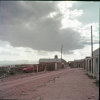Season when the Thunder Sleeps
In traditional Navajo stories about Grandmother Spider, the figure who taught weaving to First Woman, the Season when the Thunder Sleeps refers to Winter and Spring when there are no thunderstorms. It is during this time that the Navajo believe it is safe to speak of dangerous spirits. This means that the Season when Thunder Sleeps is the only time that certain teachings, healings, and ceremonials can occur, because to participate in these events at other times would be dangerous and inappropriate.









